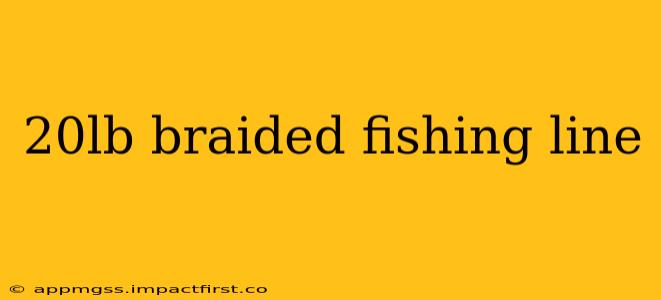Choosing the right fishing line is crucial for a successful fishing trip. Braided line, known for its strength and sensitivity, is a popular choice among anglers. This guide dives deep into the world of 20lb braided fishing line, exploring its benefits, drawbacks, and ideal applications. We'll also address common questions anglers have about this popular line weight.
What are the Advantages of Using 20lb Braided Fishing Line?
20lb braided fishing line offers a compelling blend of strength and thin diameter. This makes it incredibly versatile for a variety of fishing scenarios. Its high strength-to-diameter ratio means you can use a thinner line than with monofilament or fluorocarbon, resulting in several key advantages:
- Increased Sensitivity: The thinner diameter transmits vibrations and subtle bites more effectively, allowing you to detect even the slightest nibbles. This is particularly beneficial when targeting sensitive species or fishing in challenging conditions.
- Longer Casts: A smaller diameter line cuts through the air more easily, allowing for longer and more accurate casts, particularly advantageous when targeting fish in open water or covering larger areas.
- Superior Abrasion Resistance: While not as resistant as some specialized lines, braided line generally offers better abrasion resistance than monofilament, especially in rocky or weedy areas. This increased durability means fewer line breaks during the fight with a fish.
- No Stretch: The virtually no-stretch characteristic of braided line allows for direct connection with the lure or bait, resulting in superior hooksets and less slack in the line. This is critical for setting the hook quickly and efficiently, especially with fast-moving fish.
What are the Disadvantages of 20lb Braided Fishing Line?
While 20lb braided fishing line offers many advantages, it also presents some drawbacks to consider:
- Visibility: Braided line is often highly visible in the water, which can spook fish, especially in clear water conditions. This is less of a concern in murky or stained water.
- Wind Knots: The smaller diameter and lack of stretch make braided line more prone to wind knots, especially in windy conditions. Careful line management is essential to minimize this issue.
- Abrasion on Guides: The abrasive nature of braided line can wear down fishing rod guides more quickly than monofilament. Regular inspection and replacement of guides as needed is recommended.
- Cost: Braided line tends to be more expensive than monofilament.
What Types of Fishing is 20lb Braided Line Best Suited For?
20lb braided line is a versatile choice suitable for a range of fishing applications, including:
- Bass Fishing: Its strength is ideal for handling powerful bass, while its sensitivity allows for detecting subtle bites.
- Saltwater Fishing: The strength and abrasion resistance make it a good choice for saltwater fishing, especially for species that inhabit rocky or weedy areas. However, visibility can be a concern in clearer waters.
- Catfishing: Its high strength and durability are perfect for handling large and powerful catfish.
- Muskie Fishing: The sensitivity and strength are beneficial when targeting powerful muskie.
Is 20lb Braided Line Too Heavy for Smaller Fish?
While 20lb braided line might seem heavy for smaller fish, its thin diameter often offsets this concern. The increased sensitivity allows for detection of smaller bites, and the line’s strength becomes critical when fighting larger fish that might unexpectedly strike. However, for ultra-light fishing applications, a lighter line is recommended.
What is the Best Braided Fishing Line for Sensitivity?
While all braided lines offer superior sensitivity compared to monofilament, the specific sensitivity can vary between brands and constructions. Look for lines specifically marketed for sensitivity, often featuring finer weaves and advanced materials. Reading reviews and comparing line specifications will help determine the best option for your needs.
How Often Should I Replace My 20lb Braided Fishing Line?
The lifespan of your braided line depends on various factors, including usage frequency, fishing conditions, and the quality of the line itself. Regularly inspect your line for signs of wear and tear, such as fraying or nicks. Replacing it when necessary is crucial to avoid line breaks during critical moments, ensuring optimal performance and safety.
This comprehensive guide provides a detailed overview of 20lb braided fishing line. Remember to consider the specific fishing conditions and target species when choosing your line, weighing the advantages and disadvantages carefully to make an informed decision. Happy fishing!
